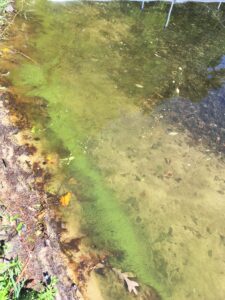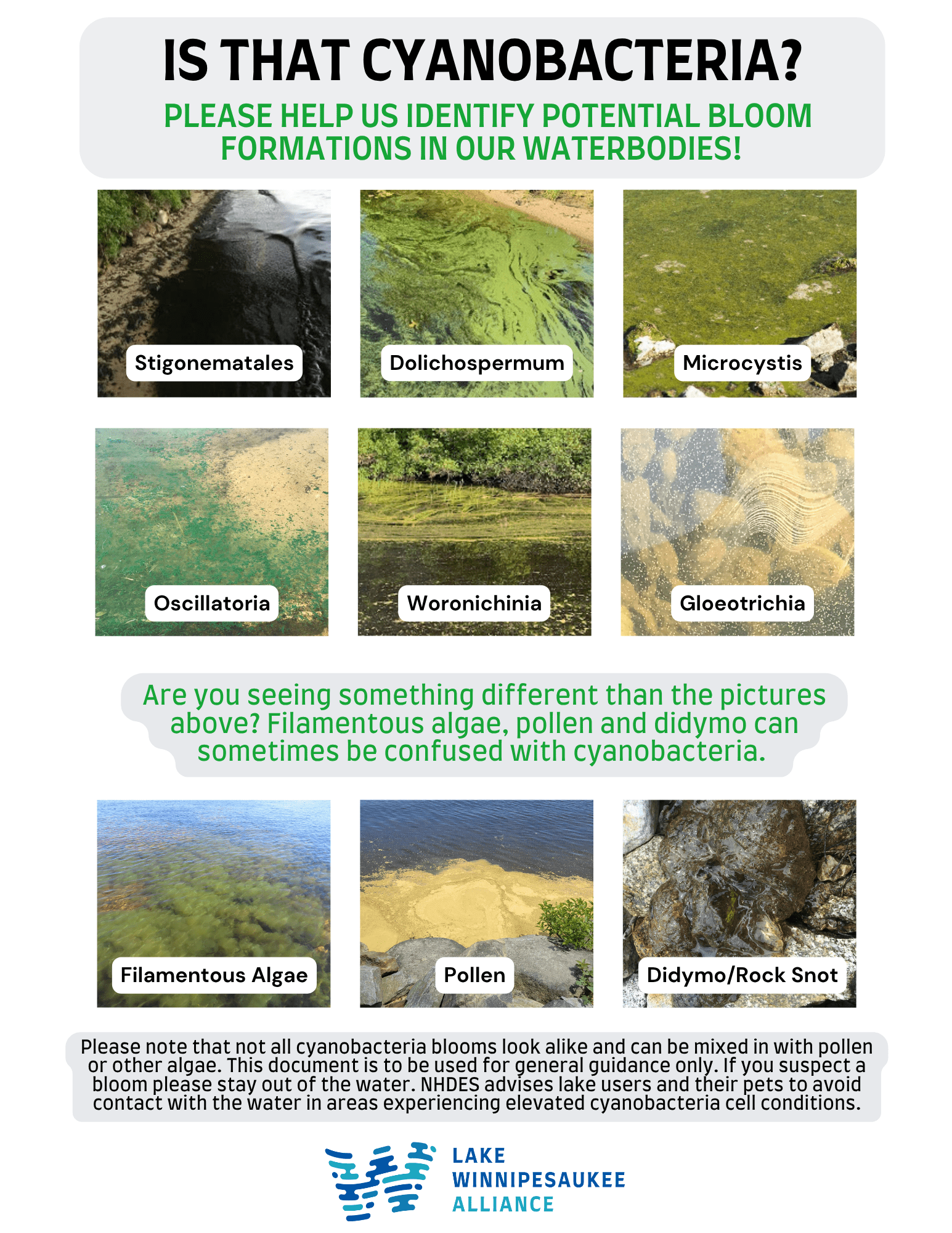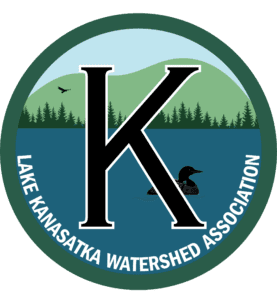Insights from the 2025 Cyanobacteria Blooms
“There is certainly a connection between the recent heavy rains…” – Laura Diemer, 6/13/2025
There is certainly a connection between the recent heavy rains, hot days, and cyano shoreline accumulations on Lake K (as well as other lakes around the state). These heavy rains generate nutrient-rich runoff into the lake that is feeding the cyanobacteria. It is also possible that septic system leachfields are saturated and overflowing minimally treated effluent to shallow groundwater and the lake. The alum treatment cut off anoxic-driven internal phosphorus load later in the summer to prevent severe whole lake blooms in late summer/fall. These blooms in early summer are largely being fed by external sources of phosphorus.
“NHDES issued a cyanobacteria report on 5/30/25…” – Laura Diemer, 6/1/2025
NHDES issued a cyanobacteria report on 5/30/25 for a green surface scum observed along the southern shoreline of Lake Kanasatka. This scum accumulation was caused by cyanobacteria surfacing and being pushed by the wind to the shore where it concentrated to bloom-level densities. As the Certified Lake Manager for Lake Kanasatka, I want to reassure the community that brief, isolated cyanobacteria accumulations like this are not unexpected. Cyanobacteria are a natural component of ecosystems and will grow with enough nutrients and light. The 2024 alum treatment reduced the internal phosphorus load from bottom sediments in deeper areas of the lake, helping to minimize the risk of large-scale, whole lake blooms. However, not all areas were treated, and shoreline accumulations may occasionally present themselves throughout the summer. Lake Kanasatka reached a tipping point a few years ago, knocking the ecosystem out of balance in favor of severe cyanobacteria blooms. We are now in the recovery phase, working hard to restore its balance. The alum treatment was a significant step, and continued watershed stewardship remains equally important. Continued monitoring by UNH LLMP and its volunteers will critically serve as the lake’s annual “check-up” and help us to track the efficacy of the alum treatment and watershed efforts over time. Thank you for your ongoing commitment to restoring and protecting Lake Kanasatka!
“It is unlikely that cyanobacteria will be fully eradicated…” – Lake Kanasatka WMP
It is unlikely that cyanobacteria will be fully eradicated in the Lake Kanasatka watershed; some species of cyanobacteria can become dormant in sediment and then can jump-start cell reproduction once conditions are favorable (warm water temperatures and plenty of sunlight and nutrients). Given the long-term trend of increasing hypolimnion total phosphorus concentration in the lake, the likelihood of blooms will continue and possibly accelerate, though year-to-year variability in weather may determine the availability of phosphorus and/or the presence of other oxygen compounds such as nitrates and thus determine the timing, extent, and severity of blooms in any given year. Despite this, conditions favorable for blooms can be substantially minimized by reducing nutrient-rich runoff from the landscape during warm, sunny spells. Water level and flow also helps to either flush out blooms or limit upstream nutrient sources to stymie growth.
Interested in learning more about the alum treatment? Read the final report.
Stay Up-to-Date on Harmful Algal Blooms This Summer
NHDES recommends reviewing these resources before heading to the lake:
1.) Sign up for weekly updates
- 2.) View warnings on the NHDES Healthy Swimming Mapper
- 3.) Get alerts for specific waterbodies
- For more information about Harmful Algal Blooms (HABs), visit:
- www.des.nh.gov/water/healthy-swimming/harmful-algal-blooms
Report a Cyanobacteria Bloom on Lake Kanasatka
-
Cyanobacteria can look like clouds, scum, mats, streaks or clumps along the shore in the water. There is no way to know if a bloom is toxic just by looking – WHEN IN DOUBT STAY OUT! Avoid the water if a suspected bloom is present to protect yourself and your pets. If you suspect a cyanobacteria bloom on Lake Kanasatka please contact Kevin Kelly at cyanobacteria.kevinkelly@gmail.com or (781) 835-9029 AND fill out the NHDES Bloom Report Form.
What are Cyanobacteria?

Cyanobacteria are small photosynthesizing, sometimes nitrogen-fixing, single celled bacteria that grow in colonies in freshwater systems. Cyanobacteria blooms can (but not always) produce microcystins and other toxins that pose a serious health risk to humans, pets, livestock, and wildlife, such as neurological, liver, kidney, and reproductive organ damage, gastrointestinal pain or illness, vomiting, eye, ear, and skin irritation, mouth blistering, tumor growth, seizure, or death. Blooms can form dense mats or surface scum that can occur within the water column or along the shoreline. Dried scum along the shoreline can harbor high concentrations of microcystins that can re-enter a waterbody months later.
There are several different species of cyanobacteria, such as:
- Anabaena/Dolichospermum: typically observed as filaments, associated with microcystins, anatoxins, saxitoxins, and cylindrospermopsin, documented in Lake Kanasatka in 2020, 2021 and 2022.
For a detailed history of cyanobacteria blooms documented on Lake Kanasatka from 2009-2021 navigate to 2.1.5 Phytoplankton (Cyanobacteria) and Zooplankton on page 15 of the Lake Kanasatka Watershed Management Plan.
Cyanobacteria Presentation from Amanda McQuaid
(Professor of Water Quality and Ecotoxicology/Director of LLMP Program, UNH Cooperative Extension)
Click Here for a Cyanobacteria FAQs List
Why are we seeing blooms more frequently?
Cyanobacteria are becoming more prevalent in low-nutrient lake systems likely due to climate change warming effects (e.g., warmer water temperatures, prolonged thermal stratification, increased stability, reduced mixing, and lower flushing rates at critical low-flow periods that allow for longer residence times) that allow cyanobacteria to thrive and outcompete other phytoplankton species (Przytulska, Bartosiewicz, & Vincent, 2017; Paerl, 2018; Favot, et al., 2019).
In addition to warming waters, cyanobacteria blooms are a result of excessive nutrients, in particular phosphorus. Sources of phosphorus in the watershed include development, stormwater runoff, shoreline erosion, fertilizer, poorly or non-functioning septic systems, and animal waste
Fact Sheets and Resources
NHDES HABs Infographic
Blooms and Mats Observed Across Several NH Lakes NHDES Press Release
NHDES Harmful Algal Blooms Website
“The Dirty Dozen” 12 Toxic Cyanobacteria of New England
UNH: What are Cyanobacteria and Why Should You Care?
History of Cyanobacteria Blooms on Lake Kanasatka
2025
6/10/2025 – 6/25/2025 (Dolichospermum)
2024
6/26/2024 – 7/3/2024 (Dolichospermum, Microcystis)
8/28/2024 – 9/4/2024 (Oscillatoria, Dolichospermum, Woronchinia)
2023 (Total of 127 Days)
6/2/2023-6/16/2023
8/7/2023-8/31/2023
9/22/2023-12/14/2023
12/26/2023-01/02/2024
2020-2022
8/12/2020 – 8/27/2020 (Anabaena/Dolichospermum)
9/29/2020– 10/09/2020 (Anabaena/Dolichospermum/Microcystis, Woronichinia/Aphanizomenon/Gloeotrichia)
8/4/2021 – 8/18/2021 (Dolichospermum)
9/13/2021 – 9/21/2021(Dolichospermum)
7/29/2022 – 8/11/2022 (Dolichospermum/Anabaena/Tolypothrix/Calothrix)
8/29/2022 – 11/16/2022 (Dolichospermum)


